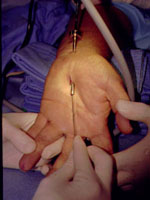| Carpal Tunnel Release
Carpal tunnel syndrome (CTS) is the most common compression neuropathy (nerve entrapment) of the upper extremity. It was initially described in 1854, and the first carpal tunnel release (CTR) was performed in 1933. It wasn't until the 1950's, however, until it became a widely recognized entity and consistently treated with carpal tunnel release.
CTS is manifested by pain, numbness, and tingling of the thumb, index, middle, and ring fingers. Symptoms can be intermittent or constant, and are usually more severe at night, frequently waking patients from sleep. Certain daily activities, such as driving, seem to exacerbate or initiate the symptoms. Several conditions are associated with a higher incidence of CTS including rheumatoid and degenerative arthritis, fractures, diabetes, thyroid disease, kidney disease requiring dialysis, pregnancy, and repetitive use.
The carpal (wrist) tunnel is a channel through which the median nerve and the nine flexor tendons (two to each digit, one to the thumb) run. It is bordered by the wrist bones on its deep side, and by the transverse carpal ligament (TCL) on its superficial side. Symptoms of CTS can occur when the size of the carpal tunnel decreases (e.g., wrist fracture) or the content of the carpal tunnel increases (e.g., tendon thickening). When either of these scenarios develops, increased pressure on the median nerve causes pain and abnormal sensation.
Non-operative treatment includes wrist splints, usually worn at night , as well as oral anti-inflammatory agents. Cortisone injections are frequently helpful, and occasionally can be curative. Nerve conduction studies may prove helpful if the diagnosis is in question. Definitive treatment is CTR.
Open CTR has been the surgical treatment of choice until the late 1980's, when endoscopic CTR (ECTR) was first described. There are several different techniques, including the two portal, or two incision, technique (see photo). Any of these procedures should be performed only by a surgeon with specialty training. Dr. Freedman is the only surgeon currently performing ECTR in the Coachella Valley. Endoscopic CTR allows division of the TCL from the bottom up by making two small incisions on either end of the TCL, versus from the top down for open CTR. This reduces the severity of post-op palm base pain, and allows a more rapid functional recovery and earlier return to work. Steristrips rather than sutures are used to close the two portal sites, and only a soft dressing is necessary post-op. ECTR is very well tolerated and usually preferred in patients who are surgical candidates.

|